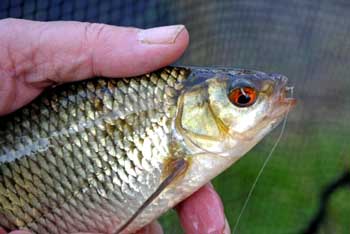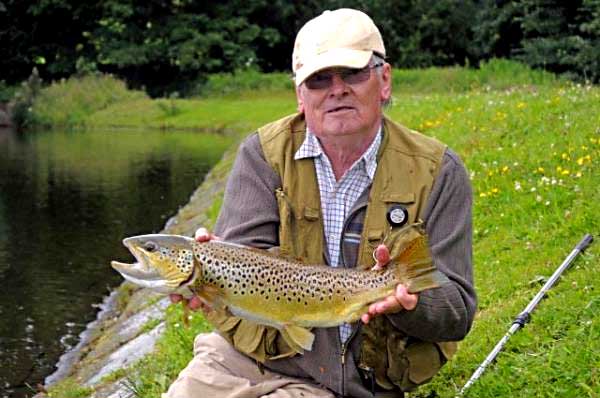
Ron Clay and a big brown trout he caught recently
During the past two years I have done a lot more fly-fishing than usual. I think this has been partly due to me taking out a couple of season tickets, first of all on Thrybergh Reservoir, which is located between Rotherham and Doncaster, and Wharncliffe Reservoir, which is north of Sheffield on the Stocksbridge bypass.
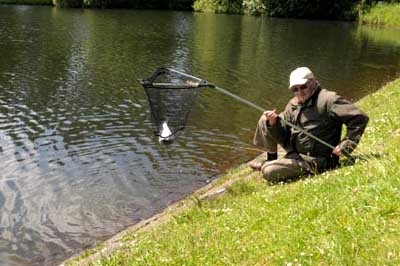 But I think there have been other reasons more complex than that.
But I think there have been other reasons more complex than that.
I first fell under the spell of fly-fishing in the 50s when I saw a man fishing for chub on the Chesterfield canal between Worksop and Shireoaks. He caught what looked like a massive chub to my young eyes, but I suppose it was no more than about 2lbs. It wasn’t the chub that impressed me as much as the way it had been caught. The angler showed me his tackle and the fly he had used, a big bushy Coch-y-Bondhu if I remember right; he also pointed me in the direction of a tackle shop where he had bought it.
As a result I went and spent my Saturday sixpence on two flies, which unfortunately were lost in the mouths of two canal chub the following day, all due to inexperience of course.
During the early 60s I acquired some proper fly tackle and spent a few days at Ladybower Reservoir where I managed to catch my first trout on the fly rod. Since then I have fished for not only trout, but over 40 other species on the fly, all over the world.
Recently a few people have been asking me why most trout waters have a fly only rule? Why do they have to buy a different and to some, completely alien set of tackle? And why do they have to take lessons in how to cast?
And why can’t they use a waggler float and maggots??
The reasons for the fly only rule on most trout waters are complex. The most logical answers to these questions, were stated many years ago by Richard Walker:
“There can be no doubt that, once an angler has become reasonably proficient in the art of fly fishing, it is the most enjoyable way of catching trout. I will go further: a standard of ability in fly fishing can be reached that makes it not only the most enjoyable but also the most successful method to use on most if not all waters.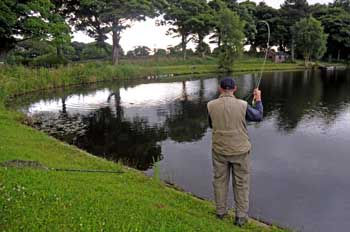 It is not, however, the easiest method for the beginner. The motivations behind the fly-only rule are, first, that those who are good enough to find it the most enjoyable method are anxious that others should lean the art and thus share their pleasure, a worthy motive. But second, if on many of our waters bait fishing were to be permitted, numbers of anglers too lazy or too stupid to learn fly fishing, would be able to pull out as many trout as the skilful fly fishers, greatly increasing the total catch and thus stocking costs, leading in turn to massive increases in day and season ticket prices.”
It is not, however, the easiest method for the beginner. The motivations behind the fly-only rule are, first, that those who are good enough to find it the most enjoyable method are anxious that others should lean the art and thus share their pleasure, a worthy motive. But second, if on many of our waters bait fishing were to be permitted, numbers of anglers too lazy or too stupid to learn fly fishing, would be able to pull out as many trout as the skilful fly fishers, greatly increasing the total catch and thus stocking costs, leading in turn to massive increases in day and season ticket prices.”
R.W.
I should also point out that these days, there are many trout waters that allow trout to be caught and released. There is no doubt that the use of baits such as worms or maggots would mean that many trout hooked would be incapable of being returned to the water as trout have more than a tendency to swallow these sorts of baits. And, I’m afraid, disgorgers have a tendency to kill trout.
But why do I, and many other fly fishermen like what we do so much?
To me, it has for many years now, been the most enjoyable form of angling, not only just for trout, but for other species too. It is the ultimate deception and it also incorporates an art form that no other style of angling, save perhaps lure fishing provides, and that is the possibility of creating that ultimate deception yourself.
And of course casting the fly is a whole art in itself too.
Fly Lines
One of the advantages of reaching retirement age is that people like myself can write from experience on a whole variety of subjects, one of them being the evolution of fly lines. Way back in 1960, I acquired a silk fly line with the brand name: “Kingfisher”. I bought it second hand from a tackle shop in Sheffield and even then it cost me a couple of quid, which was a lot of money to a junior draughtsman in those days.
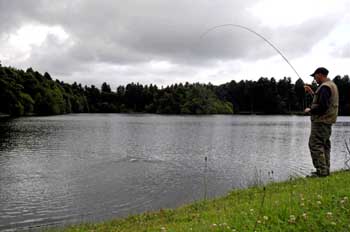 These silk lines were braided, and they tapered. The taper had to be built in by hand, a costly and labourious process. If you wanted the line to float, you had to treat it with line grease. Mucilin, still available today, was one of the best greases. But the floatability only lasted about 5 hours and then you had to re-grease it or it would sink. At the end of a day’s fishing, you had to dry out the line carefully, typically by wrapping it around the back of a chair.
These silk lines were braided, and they tapered. The taper had to be built in by hand, a costly and labourious process. If you wanted the line to float, you had to treat it with line grease. Mucilin, still available today, was one of the best greases. But the floatability only lasted about 5 hours and then you had to re-grease it or it would sink. At the end of a day’s fishing, you had to dry out the line carefully, typically by wrapping it around the back of a chair.
However one the most advantageous properties of Kingfisher double taper braided silk lines was that they had very little stretch! This made the line extremely sensitive to the take of a fish, especially if you were fishing the wet fly. Another point forgotten by many was that we used a gut cast attached to the front of the silk line. Gut also had very low stretch!
Then inevitably progress in polymer technology gave us Polyvinyl Chloride (PVC) coated monofilament fly lines which could be produced at a much lower cost than the silk lines. The PVC coating could be manufactured with minute air bubbles in it giving us floating lines we didn’t need to treat, and lead impregnated lines which sank. And these lines were not affected by water and did not require the loving care that had to be metered out to the silk lines.
“The Holy Grail” had arrived!
But had it?
Many fly fishers complained bitterly about the fact that compared to the silk lines, the new plastic ones were stretchy beyond belief. And when attached to a equally stretchy cast (leader) made of nylon, the sensitivity that had been a hallmark of tapered silk lines was lost.
As the years passed, the new PVC lines improved, but they were still stretchy, and many yearned for the old silk lines. Then along came a British company who attempted to make a non-stretch line using a braided core of Kevlar. And not only that but they utilized polyurethane as the fly line coating instead of PVC. Such ideas seemed to have solved the problem but in practice the lines were terrible and had memories that caused them to lay like a corkscrew on the water. As time passed, this company, now well known as Airflo, developed sinking lines which ultimately proved to be the best in the world, but a satisfactory floater eluded them……..
Until recently that is.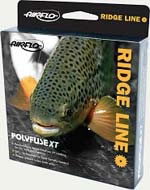
The new “Airflo Ridge Ultra Supple” lines have very little stretch and although they do have a little bit of memory, it is not a problem. I have been using one of these lines quite recently and have to say I have been very impressed indeed. I have caught a large number of trout, a percentage of which I am convinced I would not have landed with a normal PVC line. Many of the takes have been felt like a mild electric shock, so good are these non-stretch lines capable of transmitting bites!
Yet there are still a few who will not endorse them.
Blue Trout
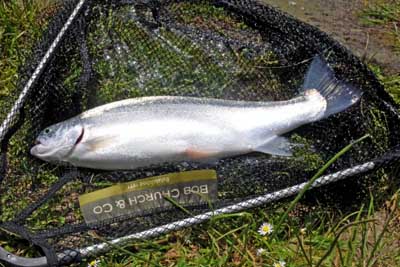 During the past few years, a mutation of the rainbow trout – Onchoryncus mykiss, has been stocked in many stillwaters. It is known as the “Blue Trout” for reasons of its colour. It is predominantly silver like a fresh run salmon, but has a blue flush on its back and sides, which is extremely attractive. It also fights very, very hard!
During the past few years, a mutation of the rainbow trout – Onchoryncus mykiss, has been stocked in many stillwaters. It is known as the “Blue Trout” for reasons of its colour. It is predominantly silver like a fresh run salmon, but has a blue flush on its back and sides, which is extremely attractive. It also fights very, very hard!
During the past year or so I have caught upwards of 30 of these fish and every one has fought with an agility and aggression that has been truly remarkable. Some have leapt high in the air several times. Others have taken over 60 yards of backing in a blinding non-stop run.
All have put up the most remarkable resistance to being hooked and not only that, the few I have kept for the pot have eaten remarkably well.
Yet there are those who will deprecate the fighting qualities of the blue trout, saying that the legendary fighting power is just that – a legend or myth.
Frankly I often wonder just how much fishing certain anglers who are quick with critical comments have done, especially when others that I have questioned, who have vast experience of all types of trout fishing, fully agree with me on this point.
Rudd on the fly
And finally, Wharncliffe Reservoir contains a good number of coarse fish, notably roach, rudd and perch. The perch go up to over 2 lbs, the roach are small yet the rudd I am told have reached 2 lbs and more in the past.
I have taken several rudd recently including a rudd/roach hybrid. However a little while ago I hit a fish which felt for all the world like a brown trout of about 1 ½ lbs or so. I played it carefully for a little while on my 3 lb tippet, and then a fish materialized from the depths. A flash of gold and the brilliant orangy red fins confirmed a rudd, and a big one too.
And with that, the fish rolled off.










